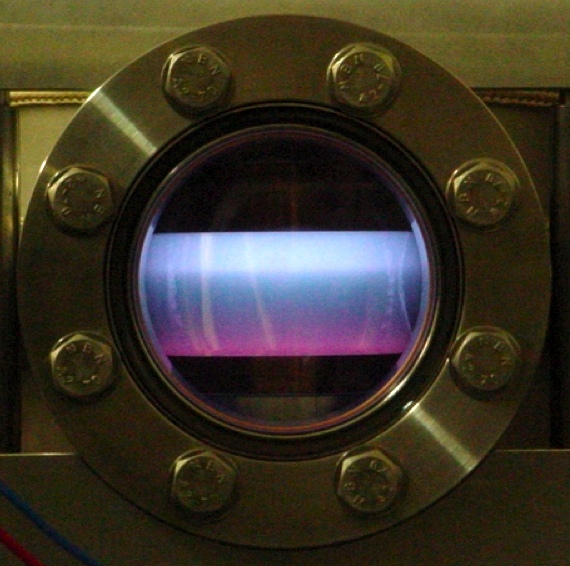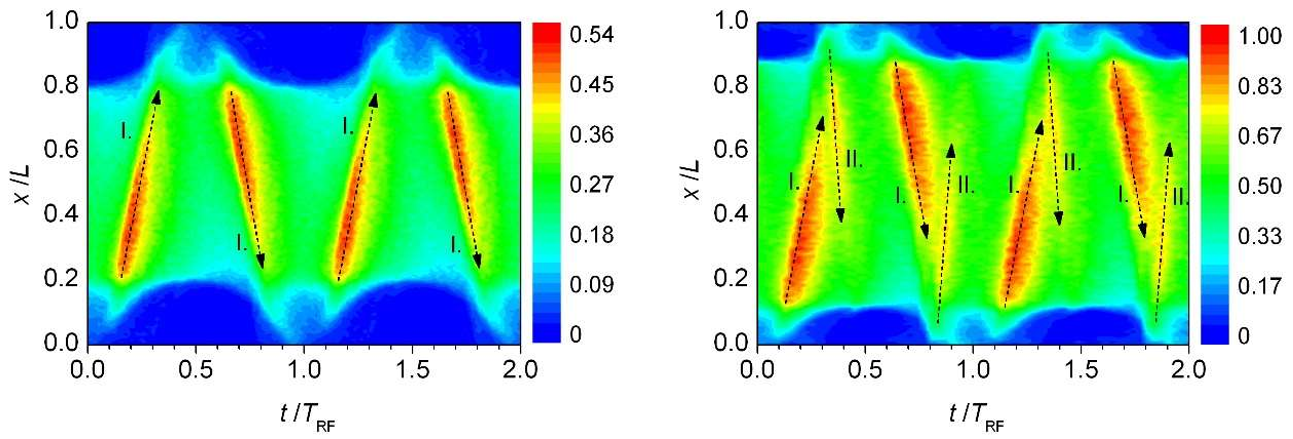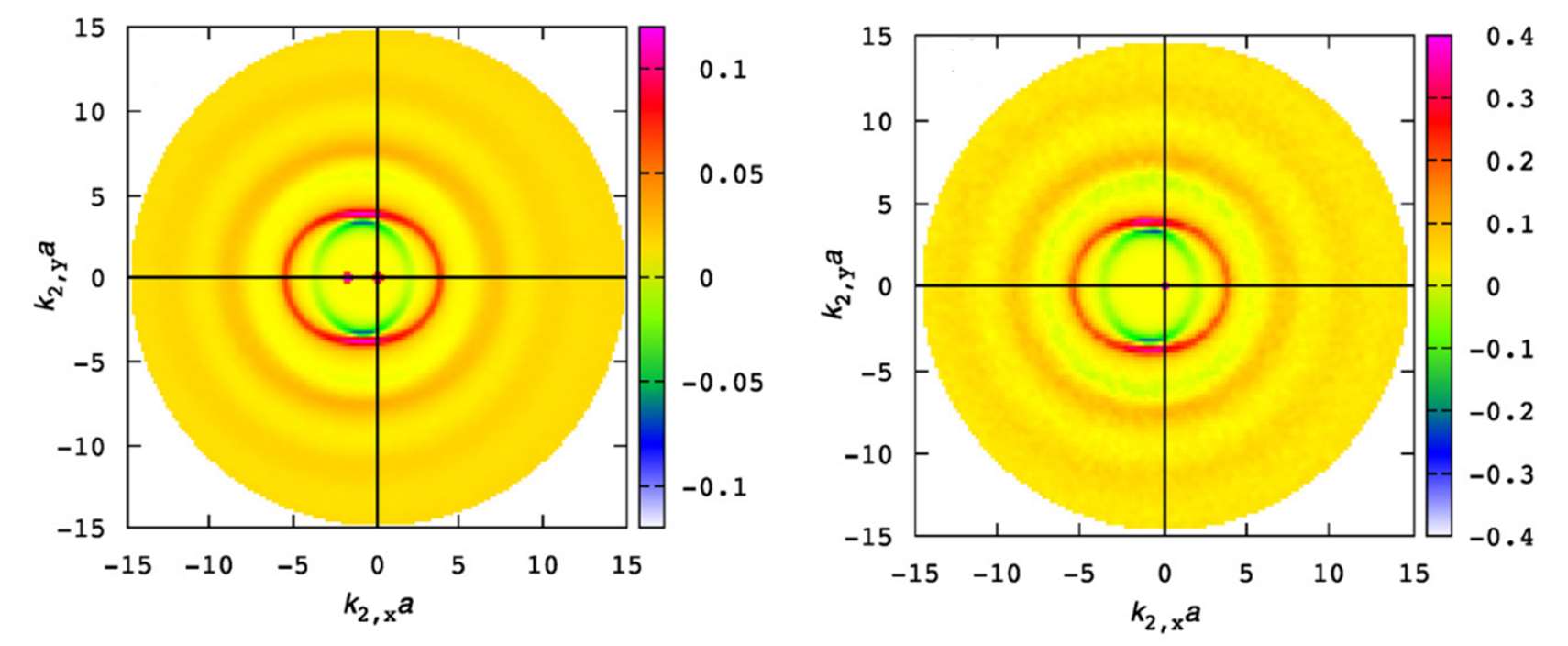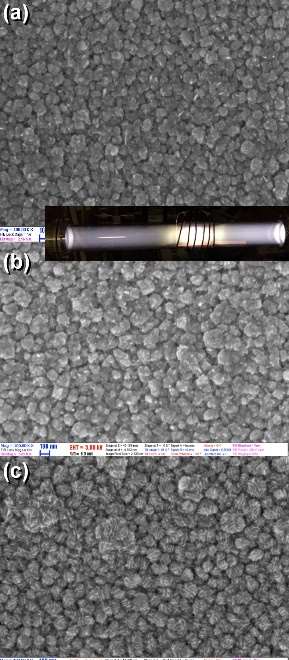Gas discharge physics
Contact: Zoltán DONKÓ

Gas discharge physics. – We have addressed several aspects of charged particle kinetics and transport in low-temperature plasmas. Particular attention has been devoted to the nonlinear effects, like the spontaneous pattern formation in electronegative discharge plasmas driven by radiofrequency (RF) voltage sources. In strongly electronegative gases, like carbon-tetraflouride, a positive ion – negative ion plasma is formed with a strongly depleted electron density, due to the (dissociative) electron attachment to molecules, which this way form negative ions. We have shown that a resonance between the excitation (radio) frequency and the eigenfrequency of the ion-ion plasma leads to an instability, which, in
turn, creates prominent non-linear structures. The dependence of this pattern formation mechanism on the discharge conditions, such as the driving voltage amplitude and frequency, as well as the electrode separation and gas pressure, has been studied in detail. By using our Particle-in-Cell/Monte-Carlo Collisions (PIC/MCC) simulation code, we have investigated the electron heating and ionization dynamics in capacitively coupled oxygen discharges driven by tailored voltage waveforms at different fundamental frequencies and at different pressures. We have found transitions of the discharge electron heating mode from the drift-ambipolar mode to the α-mode, induced by changing the number of consecutive harmonics included in the driving voltage waveform or by changing the gas pressure. We have found that changing the number of harmonics in the waveform has a strong effect on the electronegativity of the discharge, on the generation of the DC self-bias and on the control of ion properties at the electrodes. Furthermore, we have investigated the effect of the surface quenching rate of O2(a) metastable molecules on the spatiotemporal excitation patterns. We have obtained good agreement between the spatiotemporal distributions of the excitation rates obtained from the simulations and those derived from phase-resolved optical emission spectroscopy measurements. This benchmarking study was complemented with a sensitivity analysis of the results on the rates of selected plasma-chemical reaction processes. We have developed a realistic model for the description of the electron-surface interaction in capacitively coupled plasmas and incorporated this model into our PIC/MCC simulation code. This realistic model considers the elastic reflection and the inelastic backscattering of electrons, as well as the emission of electron-induced secondary electrons taking into account the properties of the surface. By using this model, we have studied the influence of the electron-induced secondary electrons on the plasma parameters in argon gas at low pressures, for SiO2 electrodes. Compared to the results obtained by using a simplified model for the electron-surface interaction, we have found that the electron-surface interactions strongly influence the electron power absorption and ionization dynamics (see Fig. 1).

Figure 1. PIC/MCC simulation results on the spatio-temporal distributions of the ionization rate [1021m-3s-1], based on a simplified model (left plot) and a realistic model (right plot) for the electron-surface interaction. Discharge conditions: argon, SiO2 electrodes, 6.7 cm electrode gap, 0.5 Pa, 13.56 MHz, 1000 V. The horizontal axis corresponds to two RF periods. The vertical axis shows the normalized distance from the powered to the grounded electrode.
Strongly coupled plasmas. – In the field of strongly coupled plasmas (SCP), we have contributed by molecular dynamics simulations to the validation of the theoretical “method of moments” approach, which allows the determination of the characteristics of the collective modes (including their damping), based solely on static characteristics (i.e., the static structure factor, or the pair correlation function) of the plasma. We presented the first experimental measurement of the 3-point static structure factor, S(3)(k1,k2,k0), of a 2-dimensional dusty plasma liquid. The higher-order structure factor was as well computed from molecular dynamics simulations and very good agreement was obtained between the
two sets of data (see Fig. 2). Both the measurements and the simulations confirmed the existence of negative values of S(3)(k1,k2,k0); this indicates the breakdown of the convolution approximation that gives S(3)(k1,k2,k0) in a factorized form of S(2)(2-point) functions. According to the quadratic fluctuation-dissipation theorem, a changing sign of S(3)(k1,k2,k0) implies a sign change of the quadratic part of the density response function of the system and an intriguing vanishing quadratic response at a certain wavenumber. Dusty plasmas. – In the field of dusty plasma physics, we have developed a new, very simple and sensitive method to measure the sputtering rate of solid materials in stationary lowpressure gas discharges. The method is based on the balance of the centrifugal force and the confinement electric force acting on a single electrically charged dust particle in a rotating environment. We have demonstrated the use and sensitivity of this method in a capacitively coupled radio frequency argon discharge. We were able to detect a reduction of 10 nm in the diameter of a single dust particle and have measured the reduction rate of 6 nm/min of the particle radius. A magnetic field was recently shown to enhance the field-parallel heat conduction in a strongly correlated plasma whereas cross-field conduction is reduced. With threedimensional molecular dynamics simulations relevant to dusty plasmas, we have shown that in such plasmas, the magnetic field has the additional effect of inhibiting the isotropization process between field-parallel and cross-field temperature components, thus leading to the emergence of strong and long-lived temperature anisotropies when the plasma is locally
perturbed. We have presented an extended heat equation, which is able to describe this process accurately.

Figure 2. Maps of the full S(3)(k1,k2,k0) 3-point static structure factor of strongly coupled Yukawa-liquids at a wave vector k1a = (1.85,0). Left: experimental data obtained on a 2-dimensional dusty plasma, right: results of molecular dynamics simulations at the same plasma parameters (a coupling coefficient of 95 and a screening coefficient of 0.7).
Technological application of high-frequency discharge systems. – Based on our experience gained during the biological decontamination studies on afterglow plasmas, we have joined another fast-developing field, namely plasma agriculture, which is aimed to develop new technology for agriculture. We used the afterglow of a surface-wave microwave discharge to investigate the effect of different afterglow plasmas on cereal crops. In our study, we treated non-infected and infected cereal crops, respectively, in the afterglow of Ar/N2-O2 surface-wave microwave discharges at 2-8 mbar pressure, using the following initial gas mixtures: (i) N2-20%O2, (ii) N2-10%O2, (iii) N2-2%O2, (iv) Ar-20%O2, (v) Ar-40%O2 and (vi) Ar-20%O2 + N2-2%O2, which made possible to isolate different species and identify their role in the process. We have shown that the germination and vigour of non-infected seeds are not significantly effected when barley is treated max 120 s at 2 mbar and maize 240 s at 4 mbar. On the other hand, seeds can be disinfected from the germination inhibitors F. graminearum and F. verticillioides. The most efficient treatment, which also increases the germination of infected seeds above 80%, is the 3 min Ar-20%O2 afterglow at 4 mbar for barley, while for maize the 4 min Ar-20%O2+2 min N2-2%O2 afterglow at 8 mbar. The high NO-content mixtures and the heating of seed surface by the recombination of O and N atoms inhibit barley germination.

Figure 3. The post-discharge system with the surface-wave microwave discharge operating in N2-20%O2 mixture during seed treatments.
We have studied the formation of oxide structures on copper plates in the discharge sheath and in the afterglow region of an inductively coupled rf discharge at different gas mixtures, input power and treatment time, as well as in the afterglow of a surface-wave microwave (mw) discharge, and compared the two systems. In the sheath of the rf discharge, regular shapes have been formed with incipient growth of nanowires as shown in Fig. 4 (a). Higher power, which results in higher temperature, contributed to thicker layer formation, while lower powers to the structuring of the oxide layer. The oxidation in the afterglow was found to be much faster, in few minutes a thick layer was formed which detached after a threshold
thickness. Depending on the oxygen content and gas temperature, different structures could be created. At lower O2 content mixture (50 sccmAr-10 sccm O2), larger individual structures have been formed, with the attempt of wires to grow on them. At the same low flow rate, with further decrease of the input power, wall structures were found, and, similarly, also in the afterglow of the mw discharge at 500 sccm N2 – 120 sccm O2. Fig. 4 (b)-(c) show the restructuring of the copper-oxide layer created in RF afterglow with the N2-O2 mw afterglow, showing the wall shape structuring of the initial structures. In case of Ar-O2 mw discharge, the oxidation rate is very low due to the lower temperature compared to the N2-O2. We have found that the wall structure, which is the basic element of the structures, can be created at lower oxidation rate, which is
related to lower temperature and lower O atom density. In case of a surface-wave microwave discharge system, this can be easily tuned with the gas flow rate and the position of the wave launcher along the discharge tube.

Figure 4. (a) Copper-oxide surfaces created in the discharge region of the 50 sccm O2, 50 W rf discharge. (b) The copper-oxide surface created in the afterglow of the 10 sccm O2, 20 W rf discharge. (c) The (b) surface restructured in the N2-O2 mw afterglow.



